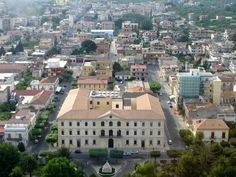Time zone CET (UTC+1) Local time Sunday 2:51 AM Dialling code 0964 | Region Calabria Demonym(s) Locresi Area 25 km² Postal code 89044 | |
 | ||
Frazioni Moschetta, San Fili, Baldari Weather 9°C, Wind NW at 11 km/h, 61% Humidity Points of interest Collezione "Scaglione" | ||
Locri is a town and comune (municipality) in the province of Reggio Calabria, Calabria, southern Italy. The name derives from the ancient Greek town Locris.
Contents
- Map of 89044 Locri Province of Reggio Calabria Italy
- History
- Modern Locri
- Locri Today
- Ionic temple of Maras
- The theatre
- Notable people
- Mass media
- References
Map of 89044 Locri, Province of Reggio Calabria, Italy
History
Epizephyrian Locris (from Greek Ἐπιζεφύριοι Λοκροί; from ἐπί epi, "on", Ζέφυρος (Zephyros, "West Wind, and the plural of Λοκρός, Lokros, "a Locrian," thus "The Locrians upon the West Wind"). was founded about 680 BC on the Italian shore of the Ionian Sea, near modern Capo Zefirio, by the Locrians, apparently by Opuntii (East Locrians) from the city of Opus, but including Ozolae (West Locrians) and Lacedaemonians. Its Latin name, Locri, is the plural of the Latin Locrus, which was used both to mean an inhabitant of Locris and the eponymous ancestor of the Locrians. Strabo suggests that it was the Ozolae who were the main founders.
Due to fierce winds at an original settlement, the settlers moved to the present site. After a century, a defensive wall was built. Outside the city there are several necropoleis, some of which are very large.
Epizephyrian Locris was one of the cities of Magna Graecia. Its renowned lawgiver Zaleucus decreed that anyone who proposed a change in the laws should do so with a noose about their neck, with which they should be hanged if the amendment did not pass. Plato called it "The flower of Italy", due to the local peoples' characteristics. Locris was the site of two great sanctuaries, that of Persephone — here worshipped as the protector of fertile marriage — and of Aphrodite.
In the early centuries Locris was allied with Sparta, and later with Syracuse. It founded two colonies of its own, Hipponion and Medma. During the Pyrrhic Wars (280-275 BC) fought between Pyrrhus of Epirus and Rome, Locris accepted a Roman garrison and fought against the Epirote king. However, the city changed sides numerous times during the war. Bronze tablets from the treasury of its Olympeum, a temple to Zeus, record payments to a 'king', generally thought to be Pyrrhus. Despite this, Pyrrhus plundered the temple of Persephone at Locris before his return to Epirus, an event which would live on in the memory of the Greeks of Italy. At the end of the war, perhaps to allay fears about its loyalty, Locris minted coins depicting a seated Rome being crowned by 'Pistis', a goddess personifying good faith and loyalty, and returned to the Roman fold.
The city was abandoned in the fifth century AD. The town was finally destroyed by the Saracens in 915. The survivors fled inland about 10 kilometres (6 mi) to the town Gerace on the slopes of the Aspromonte.
Modern Locri
After 1850 Gerace developed along the coast, forming a new centre Gerace Marina, to house new public buildings and a railway station. In 1934 it changed its name in Locri, which is now the administrative centre of the Locride area.
Locri Today
Since the twentieth century, Locri, became an important administrative and cultural center on the Ionian Coast in Province of Reggio Calabria. In Locri there are several private and public schools, Elementary, HighSchool, Liceum, Professional Schools. In Locri there are many national offices as the criminal and civil court, the bishop's office, banks, the State Archives, the tax office, the home district, the police station. In Locri there is the most important Hospital of the area, three pharmacies, but also a National Museum, two Cinema, two Cultural Centres, several sports’ centers. Today Locri has 12,488 inhabitants.
Ionic temple of Marasà
In the first half of the fifth century BC, the Locrians demolished their archaic temple and rebuilt a new temple in the Ionic style. The temple was designed by Syracusan architects around 470 BC, based on the idea of Hiero I of Syracuse.
The new temple occupies the same place as the previous one but it has a different orientation. The temple was destroyed in the 11th century. The dimensions of the temple were 45.5 by 19.8 metres (149 by 65 ft). The cella is free of supports on the central axes. The pronaos had two columns. The temple has seventeen Ionic columns on the long side, and six on the front. The height of the temple was 12 metres (39 ft).
The theatre
The theatre was built in the fourth century BC not far from the ancient city, in the Contrada Pirettina, taking advantage of a hillside slope. The original structure had space for more than 4,500 people; now only the central part of the theatre is visible.
Part of the Cavea was cut into the rocks. Each plane was divided in 7 wedges between 6 scales. A horizontal separation divided the upper theater from the lower theatre.
